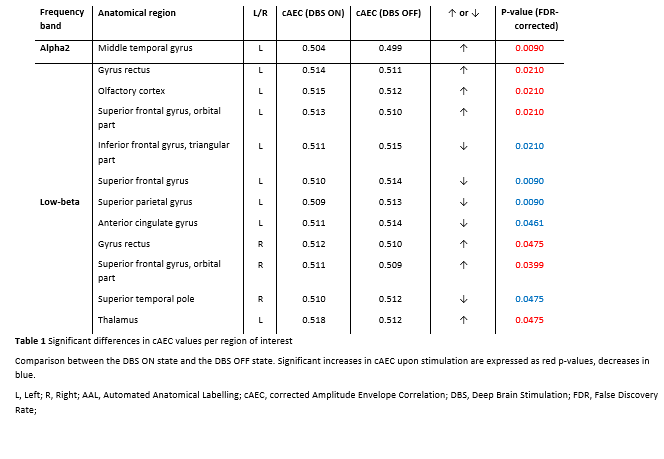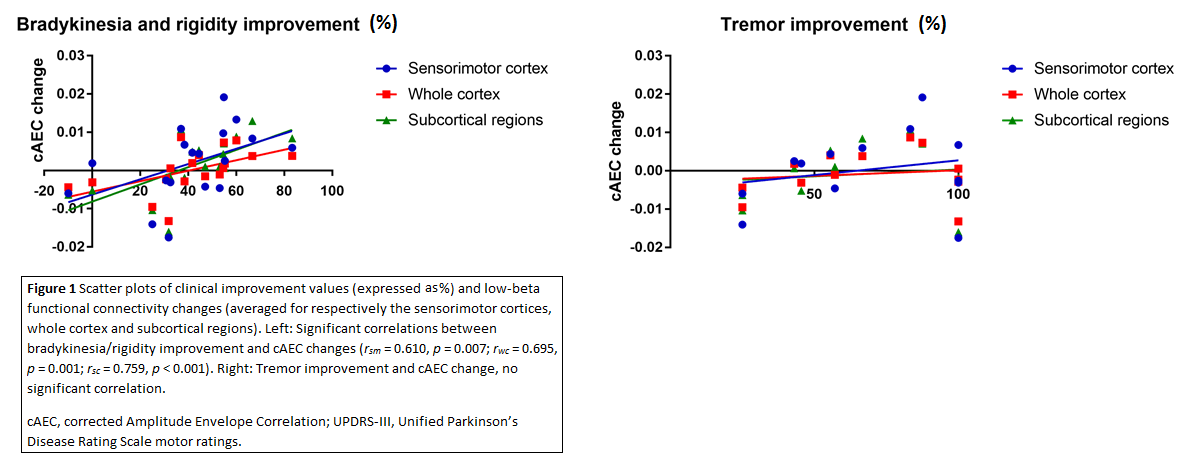Session Information
Date: Wednesday, September 25, 2019
Session Title: Surgical Therapy
Session Time: 1:15pm-2:45pm
Location: Les Muses Terrace, Level 3
Objective: To further unravel the mechanism of action of optimal deep brain stimulation (DBS) treatment effects in Parkinson’s disease (PD), by studying how DBS affects functional interactions between brain regions.
Background: DBS of the subthalamic nucleus (STN) is an excellent treatment for disabling medication related motor response fluctuations in PD, but the mechanism of action is unclear. Locally in the STN, stimulation leads to decreases in beta band power parallel to symptom relief [1, 2]. Therefore, beta band oscillations are sometimes referred to as “anti-kinetic”. However, recent studies cast doubt on the appropriateness of this label given observed functional interactions beyond the STN [3, 4].
Method: Resting-state magnetoencephalography (MEG) recordings and MDS-UPDRS-III scores were acquired in 18 PD patients with bilateral DBS of the STN, both during stimulation and without stimulation, at least six months after surgery. MEG signals were projected to both cortical and subcortical brain regions of interest (ROI) in source space, after which we estimated functional connectivity (FC) for each ROI with the rest of the brain, using the Amplitude Envelope Correlation, corrected for volume conduction (cAEC).
Results: Results Distributed throughout the brain, significant changes (both decreases and increases) in alpha2 (10-13 Hz) and low-beta band 13-22 Hz) FC were observed upon stimulation [table1]. A stronger improvement in bradykinesia/rigidity was significantly related to increases in alpha2 and low-beta band FC [figure1, correlations only shown for low-beta band). This correlation involved FC at a sensorimotor cortical (rsm = 0.610, p = 0.007), whole-cortical (rwc = 0.695, p = 0.001), as well as a subcortical level (rsc = 0.759, p < 0.001). By contrast, tremor improvement did not correlate with FC changes [figure1].
Conclusion: The present study provides new insight into the mechanism of action of DBS. Our results highlight the distributed effects of stimulation on the resting-state brain and suggest that DBS-related improvements in rigidity and bradykinesia, but not tremor, may be mediated by an increase in alpha2 and low-beta FC. Beyond the local effects of DBS around the STN, FC changes in these frequency bands might therefore be considered as “pro-kinetic”.
References: 1. Brown, P. and D. Williams, Basal ganglia local field potential activity: character and functional significance in the human. Clin Neurophysiol, 2005. 116(11): p. 2510-9. 2. Kühn, A.A., et al., Reduction in subthalamic 8–35 Hz oscillatory activity correlates with clinical improvement in Parkinson’s disease. European Journal of Neuroscience, 2006. 23(7): p. 1956-1960. 3. Cao, C., et al., Levodopa Reduces the Phase lag Index of Parkinson’s Disease Patients: A Magnetoencephalographic Study. Clin EEG Neurosci, 2018: p. 1550059418781693. 4. Hirschmann, J., et al., Differential modulation of STN-cortical and cortico-muscular coherence by movement and levodopa in Parkinson’s disease. Neuroimage, 2013. 68: p. 203-213.
To cite this abstract in AMA style:
L. Boon, W. Potters, A. Hillebrand, R. de Bie, M. Bot, R. Schuurman, C. Stam, F. van Rootselaar, H. Berendse. The influence of deep brain stimulation on the Parkinson’s disease brain: functional improvement correlates with increased alpha2 and beta band functional connectivity [abstract]. Mov Disord. 2019; 34 (suppl 2). https://www.mdsabstracts.org/abstract/the-influence-of-deep-brain-stimulation-on-the-parkinsons-disease-brain-functional-improvement-correlates-with-increased-alpha2-and-beta-band-functional-connectivity/. Accessed October 22, 2025.« Back to 2019 International Congress
MDS Abstracts - https://www.mdsabstracts.org/abstract/the-influence-of-deep-brain-stimulation-on-the-parkinsons-disease-brain-functional-improvement-correlates-with-increased-alpha2-and-beta-band-functional-connectivity/


